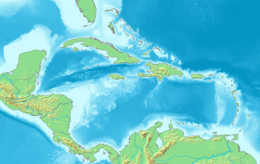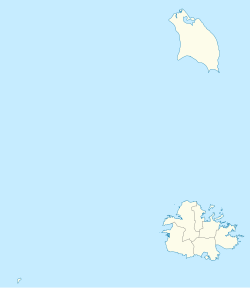Geography
Green Island is located off the southeastern peninsula of Antigua, at the southern entrance to Nonsuch Bay. Towards the mainland, the Green Bay, a bay-like strait south of the island, in front of Cape Cork Point, Green Island is only about 350 meters away from Antigua island. [2] Administratively, it belongs to the Saint Phillip Parish.
Environment
The island itself measures about two kilometers from west to east; its width varies by two south-facing peninsulas in the range of a few hundred meters (maximum 650 m), [2] forming several sheltered bays. Altogether, the island has an area of about 40ha. [3] A sea-side peninsula ends in the Man of War Point, as the eastern tip of Antigua (as a region, east point of the main island the Neck of Land), from which the Atlantic Ocean [4] extends over nearly 4,000 kilometers to the approximately latitude Cape Verde. The island rises only a few meters above sea level, and is composed of tropical brushwood and partly lined by rock, partly by pure white beaches. On both sides are reefs and rocks in front, the northern reef blocks the entire Nonsuch Bay and extends to Long Bay.
This page is based on this
Wikipedia article Text is available under the
CC BY-SA 4.0 license; additional terms may apply.
Images, videos and audio are available under their respective licenses.




